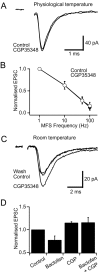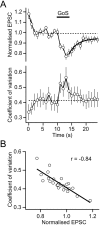GABA spillover from single inhibitory axons suppresses low-frequency excitatory transmission at the cerebellar glomerulus
- PMID: 11102470
- PMCID: PMC6773066
- DOI: 10.1523/JNEUROSCI.20-23-08651.2000
GABA spillover from single inhibitory axons suppresses low-frequency excitatory transmission at the cerebellar glomerulus
Abstract
GABA type B receptors (GABA(B)-Rs) are present on excitatory terminals throughout the CNS, but surprisingly little is known about their role in modulating neurotransmission under physiological conditions. We have investigated activation of GABA(B)-Rs on excitatory terminals within the cerebellar glomerulus, a structure where glutamatergic excitatory and GABAergic inhibitory terminals are in close apposition and make axodendritic synapses onto granule cells. Application of the GABA(B)-R agonist baclofen depressed evoked mossy fiber EPSCs by 54% at 1 Hz. The amplitude of miniature EPSCs recorded in tetrodotoxin was unchanged in the presence of baclofen, but the frequency was significantly reduced, indicating a purely presynaptic action of baclofen under our recording conditions. At physiological temperature (37 degrees C) presynaptic GABA(B)-Rs were not tonically activated by spontaneous GABA release from Golgi cells, which fire at approximately 8 Hz in slices at this temperature. However, tonic activation could be induced by blocking GABA uptake or by lowering temperature. GABA(B)-Rs were activated at physiological temperature when Golgi cell firing was increased above the basal level by stimulating a single inhibitory Golgi cell input at 50 Hz, suppressing the mossy fiber-evoked EPSC by 24% at 1 Hz. Furthermore, glutamate release was selectively inhibited at low-frequency mossy fiber inputs (<10 Hz) during Golgi cell stimulation. Our findings suggest that GABA spillover in the glomerulus modulates sensory input to the cerebellar cortex.
Figures








Similar articles
-
Tonic and synaptically evoked presynaptic inhibition of sensory input to the rat olfactory bulb via GABA(B) heteroreceptors.J Neurophysiol. 2000 Sep;84(3):1194-203. doi: 10.1152/jn.2000.84.3.1194. J Neurophysiol. 2000. PMID: 10979995
-
Activation of postsynaptic GABAB receptors modulates the bursting pattern and synaptic activity of olfactory bulb juxtaglomerular neurons.J Neurophysiol. 2008 Jan;99(1):308-19. doi: 10.1152/jn.01086.2007. Epub 2007 Nov 21. J Neurophysiol. 2008. PMID: 18032562 Free PMC article.
-
Pre- and postsynaptic inhibition mediated by GABA(B) receptors in cerebellar inhibitory interneurons.J Neurophysiol. 2002 Jan;87(1):183-90. doi: 10.1152/jn.00344.2001. J Neurophysiol. 2002. PMID: 11784741
-
Integration and regulation of glomerular inhibition in the cerebellar granular layer circuit.Front Cell Neurosci. 2014 Feb 25;8:55. doi: 10.3389/fncel.2014.00055. eCollection 2014. Front Cell Neurosci. 2014. PMID: 24616663 Free PMC article. Review.
-
International Union of Pharmacology. XXXIII. Mammalian gamma-aminobutyric acid(B) receptors: structure and function.Pharmacol Rev. 2002 Jun;54(2):247-64. doi: 10.1124/pr.54.2.247. Pharmacol Rev. 2002. PMID: 12037141 Review.
Cited by
-
Hyperpolarization induces a long-term increase in the spontaneous firing rate of cerebellar Golgi cells.J Neurosci. 2013 Apr 3;33(14):5895-902. doi: 10.1523/JNEUROSCI.4052-12.2013. J Neurosci. 2013. PMID: 23554471 Free PMC article.
-
Rapid vesicular release, quantal variability, and spillover contribute to the precision and reliability of transmission at a glomerular synapse.J Neurosci. 2005 Sep 7;25(36):8173-87. doi: 10.1523/JNEUROSCI.2051-05.2005. J Neurosci. 2005. PMID: 16148225 Free PMC article.
-
Neurotransmitter content heterogeneity within an interneuron class shapes inhibitory transmission at a central synapse.Front Cell Neurosci. 2023 Jan 4;16:1060189. doi: 10.3389/fncel.2022.1060189. eCollection 2022. Front Cell Neurosci. 2023. PMID: 36687523 Free PMC article.
-
Identification of an inhibitory circuit that regulates cerebellar Golgi cell activity.Neuron. 2012 Jan 12;73(1):149-58. doi: 10.1016/j.neuron.2011.10.030. Neuron. 2012. PMID: 22243753 Free PMC article.
-
Modeling the Cerebellar Microcircuit: New Strategies for a Long-Standing Issue.Front Cell Neurosci. 2016 Jul 8;10:176. doi: 10.3389/fncel.2016.00176. eCollection 2016. Front Cell Neurosci. 2016. PMID: 27458345 Free PMC article. Review.
References
-
- Abbott LF, Varela JA, Sen K, Nelson SB. Synaptic depression and cortical gain control. Science. 1997;275:220–224. - PubMed
-
- Aroniadou-Anderjaska V, Zhou F-M, Priest CA, Ennis M, Shipley MT. Tonic and synaptically evoked presynaptic inhibition of sensory input to the rat olfactory bulb via GABAB heteroreceptors. J Neurophysiol. 2000;84:1194–1203. - PubMed
-
- Barbour B, Häusser M. Intersynaptic diffusion of neurotransmitter. Trends Neurosci. 1997;20:377–384. - PubMed
-
- Bean BP. Neurotransmitter inhibition of neuronal calcium currents by changes in channel voltage dependence. Nature. 1989;340:153–156. - PubMed
-
- Brenowitz S, David J, Trussell L. Enhancement of synaptic efficacy by presynaptic GABA(B) receptors. Neuron. 1998;20:135–141. - PubMed
Publication types
MeSH terms
Substances
Grants and funding
LinkOut - more resources
Full Text Sources
